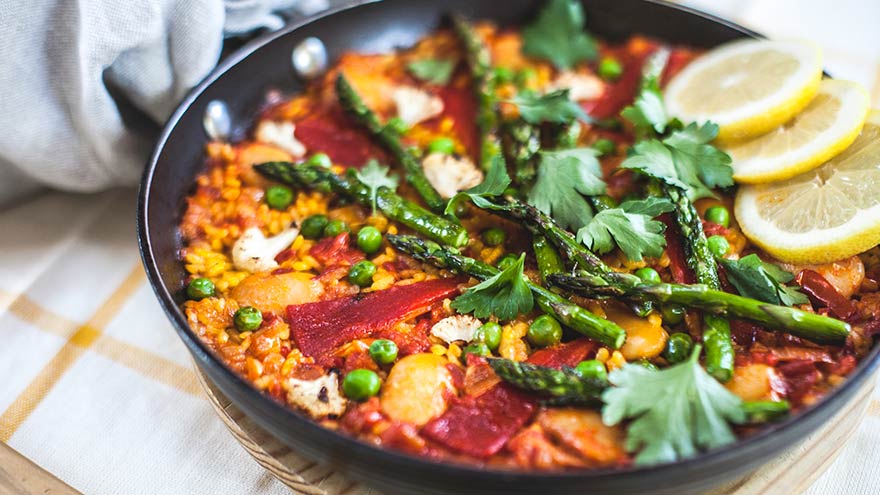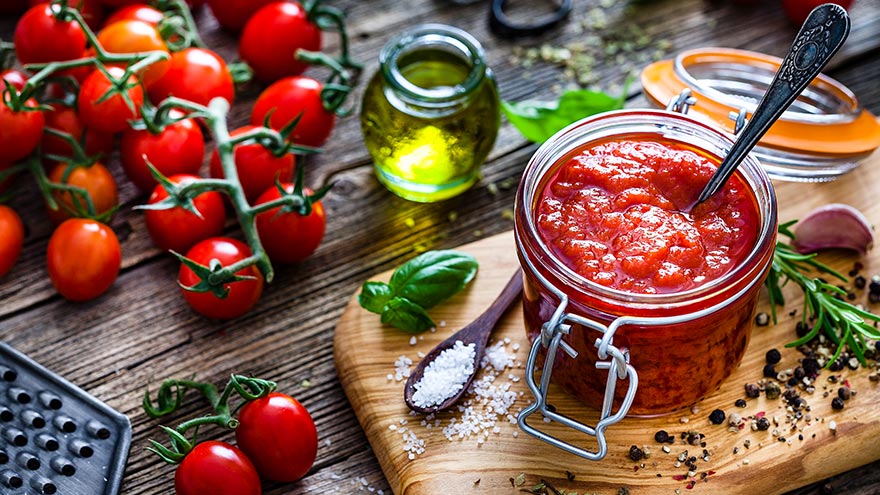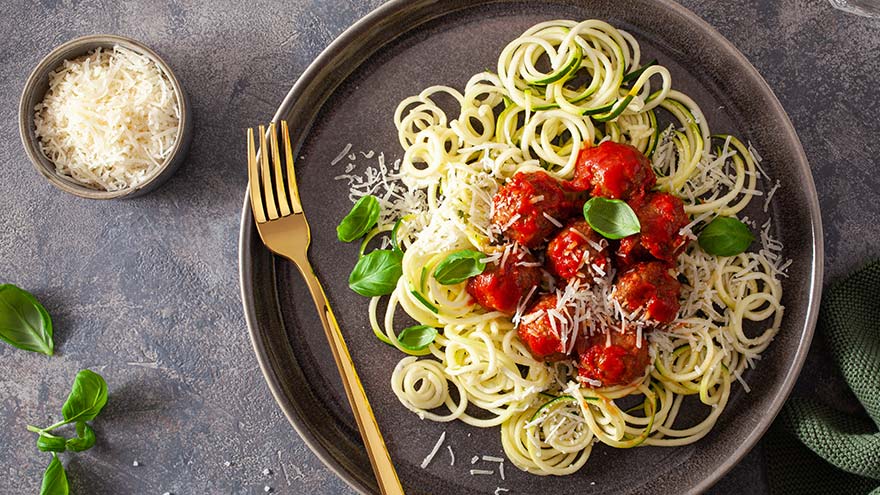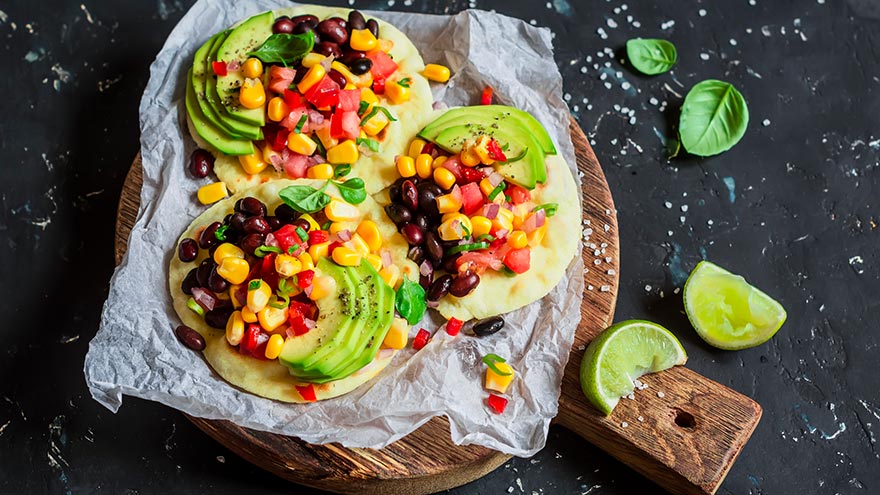Search
-
Get Spicy! Try This Easy Heart-Healthy Vegan Paella
Enjoy the heartiness of traditional paella without any added salt or meat. This recipe is also low in fat, making it a good heart-healthy choice for lowering cholesterol and blood pressure.
Read More About Get Spicy! Try This Easy Heart-Healthy Vegan Paella
-
Make Your Own Trail Mix: 4 Quick and Easy Recipes
Craving a snack with crunch, sweet flavor and a powerful nutritious punch? These healthy, homemade variants of this make-it-and-take-it super snack are sure to satisfy your sweet tooth and your healthy lifestyle. Who says healthy snacks and bland taste go together? We say you can have it all — nutritious and delicious snack foods that taste great and satisfy — and trail mix fits the bill. Your homemade batch can be as healthy as you like. The nuts provide fiber, protein and a whole lot of crunchy goodness; dried fruit and touches of chocolate infuse the mix with just the right amount of sweetness. We’ve compiled some simple-to-make and hard-to-resist recipes so you can easily pick up a few items from the grocery store’s bulk bins, or your kitchen cupboard, and put together a snack for your kiddos lunches or the office. Better yet, grab your mix and head out for a stroll or hike, or take along on your next road trip or adventure in Nevada’s rugged, desert locales.
Read More About Make Your Own Trail Mix: 4 Quick and Easy Recipes
-
5 Tips to Protect Your Knees from Pain and Injury
Knee pain and injury can restrict movement and make it difficult to be active, but studies show that the right type of exercise can help prevent these issues. It’s no wonder our knees are highly prone to injury. They house a complex network of muscles, ligaments and joints, and are crucial to our agility and daily movements. If you are experiencing knee pain, it’s important to not ignore this message from your body. While it’s fairly common to have occasional aches, if the pain limits your ability to perform normal daily activities like climbing stairs or walking with ease, have a medical professional check it out. “The take-home message here is to listen to your body,” says Amanda Henriques, PT, DPT at Renown Physical Therapy. “We are all built differently and respond to exercise in different and unique ways. Running may feel great for one person, but always lead to injury for another.” At any age, it's important to protect and strengthen your knees to help prevent pain and injury. Here are five tips from our experts: 1. Strengthen your muscles Choose exercises that focuses on the muscles around your kneecaps, hips and pelvis and places extra emphasis on your core. These muscles will absorb some of the stress places on your knees, helping them stay balanced and stable. 2. Maintain a healthy weight Each pound of body weight produces five pounds of force on the knee. If you need to shed weight, start with low-impact activities to avoid increased stress to your joints. 3. Pick the right exercise Opt for exercise that put less stress on your knees, such as cycling, walking or swimming. Choose flat surfaces when walking for exercise and avoid activities that put extra stress on your knees, such as deep knee bends or downhill running. 4. Warm up before working out Don’t overdo the workouts in length or intensity, and stretch after exercise to help prevent injury. 5. Avoid high heels Wear shoes with good arch support specific to your choice of exercise that provide a stable base for your feet and legs. Replace running shoes every 300 to 500 miles. Other athletic shoes should be replaced after 500 miles of wear. These tips can help keep your knees strong and prevent injury. But if you experience an accident or trauma, seek medical attention and follow up with any rehabilitation recommendations you receive. Depending on the injury, your doctor may recommend physical therapy, where you will be guided through individualized exercises to strengthen and heal. “If you listen to your body and take the appropriate preventative measures, you can find the right type of exercise to keep you happy, healthy and fit for life,”
Read More About 5 Tips to Protect Your Knees from Pain and Injury
-
Slow Cooker Paleo Chili
Nothing says comfort like a bowl of chili. This rich, flavorful dish is Paleo-diet friendly and ready to eat when you are.
-
How Do I Prepare for Surgery?
Renown’s team of nurses and respiratory therapists discuss what you need to know before undergoing surgery, including fasting guidelines and how to improve recovery. There are several things to know before you undergo surgery, including steps to prepare at home in advance of your procedure. Fasting Guidelines: No solid foods eight hours prior to surgery You may have clear liquids three hours before your surgery. Clear liquids include water, apple juice and lemon or lime-flavored soda water (not cola). In addition, do not chew or smoke tobacco (regular or e-cigarettes) after midnight the night before your surgery, unless instructed by your doctor or anesthesiologist.
-
Paleo Garlic Mashed No-Tatoes
This scrumptious mashed potato substitute is super easy, tasty and gluten-free.
-
DIY Heart-Healthy Marinara Sauce
The convenience of marinara sauce in a jar is pretty hard to beat. But with some extra time in the kitchen, the nutritional value of traditional sauce — already packed with good stuff — goes off the charts.
-
True Grit Healing a Cowboys Heart
At 85, James Domingos is still enjoying life as a cowboy, thanks to a transcatheter aortic valve replacement. Always rolling with the punches when it comes to life, 85-year-old James Domingos faced his health issues with the same grit. For many years, he roped cattle for friends and rounded up horses for the Bureau of Land Management. In recent years, a pacemaker controlled the rhythm of his heart, but didn’t slow him down. “We used to be able to take walks for 15 minutes in one direction and take the dog,” says Domingos’ wife, Joy. “Then it got to be less and less.” Tests at Renown Health revealed a heart valve was nearly closed. His heart doctor, Jake Ichino, MD, FACC, FSCAI, suggested a transcatheter aortic valve replacement, known as TAVR, which repairs a heart valve without removing the damaged valve. The procedure is recommended for patients who are at high risk for open heart surgery.
-
Use This, Not That: 8 Healthy Cooking Swaps
If you’re looking for an easy way to add a nutritious kick to your favorite brownie, pizza or cream sauce recipe, check out these healthy ingredient substitutions. There’s no doubt about it: People love decadent, creamy and starchy dishes. If you’re prone to avoiding your favorite guilty pleasure because it’s not a healthy choice, there are a few easy, healthy and delicious substitutions you can add to your cooking or baking routine to satisfy your cravings. Here are eight of our favorite healthy substitutions you might have in your kitchen right now: Baking Swaps Avocados for Butter While this might not sound like an appetizing addition, avocado's creamy texture is similar to butter and can easily be added to brownie and cookie recipes. Avocados are high in healthy fats that help to lower cholesterol and are lower in saturated fats. They also can add vitamin E, fiber and potassium to your baked goods. Swap Amount: Substitute 1 cup blended avocado per 1 cup butter. Bananas for Oil Bananas are a tasty option to replace the use of oil in baking recipes. While oil is higher in fat and calories, bananas can provide potassium, fiber, vitamin B6 and all-natural sweetness to your recipe. Do take into account that bananas are higher in sugar and carbohydrates. Swap Amount: Substitute 1 cup of mashed bananas per 1 cup of oil. Beans for Flour You might not typically think of beans as a substitution, but they can add a lot of nutritional benefits to your treats. High in protein, fiber, folate, magnesium and phosphorous, beans are a great substitution for traditional flour in recipes and create a moist and dense texture to your baked goods. Swap Amount: Substitute 1 cup of blended beans (about a 15 ounce can) per 1 cup of traditional flour. Or, Wheat Flour for White Flour If the bean substitution doesn’t appeal to you, try substituting at least half or all of your unbleached white flour for whole wheat flour. Keep in mind for every cup of whole wheat flour you use, add another 1/4 cup of water to your recipe. This will add more fiber, protein, B vitamins, and several minerals for your baking recipe and scrumptious treats. Chia Seeds or Flax Seeds for Eggs This is a great substitution if you're allergic to eggs or have a vegan diet, but still want to enjoy desserts and breads. Chia and flax seeds are high in omega-3 fatty acids and calcium along with fiber, vitamins and minerals to help promote healthy digestion. This substitution will not provide as much protein as an egg would; however, there is less cholesterol and saturated fat. Swap Amount: Combine 1 tablespoon of ground chia or flax seeds mixed with 3 tablespoons of water, stir and let sit for 15 minutes. Equals one whole egg equivalent. Cooking Swaps Nonfat Greek Yogurt for Mayonnaise Making this switch is an easy replacement for sauces and dressings. Nonfat Greek yogurt is significantly lower in fat and calories and higher in protein. With the added protein, you will feel fuller longer throughout the day. Swap Amount: Substitute equal parts nonfat Greek yogurt for mayonnaise. Try mixing it into a cheese sauce or add lemon juice and spices for a creamy salad dressing. Lemon Juice or Vinegar for Salt If you are worried that your food will be bland, try this swap to lower added salt and still enjoy flavor while creating a fresh, tangy twist to the meal. There are a lot of varieties -- red wine, apple cider and balsamic -- each enhancing your dish with a different flavor. Swap Amount: Experiment by using half the amount of vinegar or lemon juice per the amount of salt your recipe calls for. Cauliflower for Pizza Crust Try a new twist on pizza by switching out its carbohydrate dense crust with fresh cauliflower. This substitution is lower in calories, fat, and simple carbohydrates while increasing your vitamin C and vegetable intake for the day. Swap Amount: Add one egg per every head of cauliflower and season with spices to taste, for a medium sized pizza. Or, Mashed Potatoes Preparing a homemade cauliflower pizza crust can be time consuming, so an easier exchange might be to substitute mashed cauliflower for mashed potatoes, which are higher in starches, calories and carbohydrates. Swap Amount: Boil and puree a medium size head of cauliflower. Add a splash of low fat milk and season to taste. Zucchini or Squash for Spaghetti Another great way to add vegetables to your meals is to exchange ribbons of zucchini or spaghetti squash for spaghetti noodles. This substitution helps to reduce calories and carbohydrates and zucchini is rich in vitamin A. Experiment with different sauces and spices to create a variety of dishes. Swap Amount: For zucchini ribbons, try using a mandolin or a peeler. When preparing spaghetti squash, cut it in half and lay face down in an oven safe pan. Add 1/2 inch of water to the bottom of the pan for more tender spaghetti strings (optional). Cook for 30 to 45 minutes until tender. Lie the squash face up, letting it slightly cool, and then use a fork to gently pull the squash from the peel, separating into strands. Remember: Some of these substitutions will affect the taste and texture of your recipes, so it is essential to play with the ratios to find the perfect fit for you. Consume a variety of foods, eat treats in moderation, and incorporate frequent physical activity to keep a well balanced, healthy lifestyle.
-
Meatless Monday: Black Bean Tostadas
Research shows that plant-based diets can help manage — and in some cases aid — in the prevention of many chronic conditions such as diabetes, heart disease and even cancer. If you’re looking to adopt a healthier lifestyle, try incorporating more plant-based and meatless recipes into your diet — even if it’s just once a week. If you want to cut back on meat but not flavor, we’ve got you covered with this black bean tostada recipe. The list of ingredients includes a number of veggies and spices that are not only good for you, but will make your taste buds sing. The best part? This delicious, Mexican-style dish is so easy that even the most novice cook can have dinner served in just 15 minutes. Enjoy!
-
Why Can't I Eat Before Surgery?
If you’re having surgery on your shoulder, why does it matter what’s in your stomach? We asked Dr. Matthew Hoberg to explain more about pre-surgery directives, including fasting. If you have an upcoming surgery, your care team likely gave you instructions to fast before your procedure. But why? We asked Matthew Hoberg, M.D., medical director of Renown Surgical Services, to explain why it’s important to forgo food and drinks before surgery. Why are patients instructed to fast before surgery? Regardless of surgery type or site, we want the stomach to be empty before having anesthesia, because anesthesia can reduce your body’s ability to protect and prevent food or acids from the stomach from entering the lungs. Normally, your body is able to prevent this, but anesthesia medicines make it harder for your body to do so. When food or liquids from the stomach get into the lungs, doctors call it “aspiration.” This is rare, but can be dangerous if it does happen. Solid foods and liquids leave the stomach at different rates too. Solid food takes longer to empty from the stomach than liquids, so the time to stop eating solids (eight hours) is longer than that for clear liquids (two hours). The body has energy reserves to produce needed nutrients and fuel during fasting. Recently, studies have shown it is important to stay hydrated and have some carbohydrates in clear liquids up to two hours before surgery, so clear liquids are allowed until two hours before surgery. There are also special rules for babies and young children who need surgery. For example, you may give breast milk up to four hours before surgery. If your baby drinks formula, you should stop six hours before surgery, and all solid foods you should stop eight hours before. Your child’s doctor or nurse will give you exact instructions. What if you show up for surgery and have broken the no-eating rule? Will surgery be re-scheduled? If patients have not followed the fasting guidelines, surgery will be postponed or rescheduled due to the possible increased risk associated with not having an empty stomach. The exception would be emergency surgery that cannot be delayed in which case special precautions are taken to help prevent anything from getting into the lungs. What other pre-operative rules should be followed to the letter? All instructions given to patients before their surgery or procedure should be followed. There are specific medical reasons behind all the instructions and they are designed for safety — to minimize risks, lower complications like infections and enhance the recovery process to help patients get back to normal as quickly as possible. Also, many patients ask if they should continue taking medications before surgery. The answer is: It depends. Your doctor or nurse will tell you which medicines you should take and when. Some medicines need to be stopped before surgery. But for others, it’s important you keep taking them as usual. You may also get new medicines to take before surgery. You may be asked to take some medications before surgery as part of advanced pain management protocols. If you need to take medicine right before your surgery, you can take it with a sip of water.
-
Super Easy Seared Salmon & Spring Salad
Watch Renown Chef Chris Wyatt blend zest and spice in this seared salmon and grilled veggie dish with a few secret ingredients. Are you looking for a new twist on an old stand-by dinner favorite while getting a heart-healthy dose of omega-3s? Look no further: Salmon recipes don’t get any easier than this. With this mouth watering recipe totaling in at just less than 350 calories, done in nearly 30 minutes, you’re going to want to make it your next meal. Added perk: Eating fish, such as salmon, twice a week has been found to lower the risk of heart attack and stroke over fish oil supplements.











